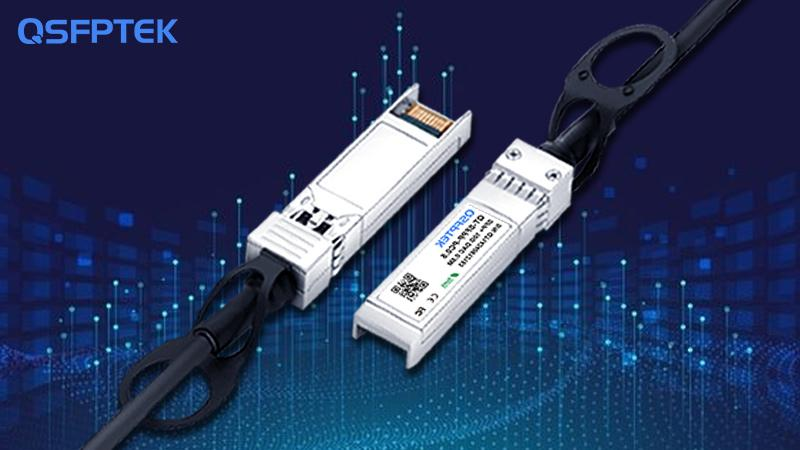As enterprises expand across multiple sites and data centers, ensuring efficient and reliable connectivity becomes a top priority. Seamless communication between geographically dispersed locations demands solutions that can provide high bandwidth, low latency, and cost efficiency. One such solution is the 10G Direct Attach Cable (DAC), a high-performance yet economical option for short-distance data centers and enterprise networking. In this blog, we will explore how 10G DAC is enhancing the flexibility of multi-site enterprise networks, as well as the challenges it faces in this evolving environment.
What is 10G DAC
10G DAC cables are copper-based, pre-terminated cables designed for short-distance connections between switches, servers, and storage devices in data centers and enterprise networks. They deliver 10Gbps speed and are typically used for distances of up to 7 meters. Unlike optical fiber solutions, which require more expensive transceivers and cabling, DAC offers a cost-effective alternative for connecting devices within the same rack or across racks close.
The Role of 10G DAC in Multi-Site Enterprise Networks
As enterprise networks scale across multiple data centers and remote locations, the need for high-speed connectivity grows. Traditionally, optical fiber connections have been used to connect sites over long distances, but DAC cables play a vital role within each site. Here’s how 10G DAC enhances the flexibility of multi-site networks:
Cost-Efficient Connectivity for Internal Data Center Links
In multi-site enterprises, connecting racks and servers within each data center is essential for maintaining efficient operations. 10G DAC provides an affordable solution for high-bandwidth connections over short distances within these facilities. Unlike fiber optics, DAC cables eliminate the need for separate transceivers, significantly reducing the overall cost of deployment.
Ease of Installation and Maintenance
One of the key advantages of using 10G DAC in multi-site networks is its simplicity. The cables are pre-terminated, meaning they can be plugged directly into ports without the need for additional configuration or complex installation processes. This ease of use is especially valuable in environments where downtime is costly, and quick installation or replacement is crucial. As enterprises grow and deploy new hardware across multiple sites, the quick deployment of 10G DAC ensures rapid scalability.
Reduced Latency for Local Data Transfers
Within each data center, minimizing latency is critical for efficient data processing and communication. 10G DAC offers extremely low latency compared to other networking solutions, such as fiber optics. For applications requiring real-time data analysis, such as big data, AI, and IoT, DAC cables can optimize the speed of internal communication between computing, storage, and networking resources.
Resilience and Redundancy in Network Architecture
Multi-site enterprises require resilient network designs to ensure business continuity. 10G DAC can be easily integrated into redundant network architectures within each site, allowing for fast failover mechanisms and improved uptime. Its reliability and performance within short-range environments make it an excellent option for building resilient internal connections within each data center or site.
Challenges of Implementing 10G DAC in Multi-Site Networks
While 10G DAC cable offers a cost-effective and efficient solution for connecting devices within data centers, it is not without its challenges, particularly in multi-site enterprise environments.
Distance Limitations
The most significant limitation of 10G DAC is its distance constraint. The maximum reach of a DAC cable is generally between 5 and 7 meters, making it unsuitable for long-distance connections between geographically dispersed sites. Enterprises must still rely on fiber optics or other long-range solutions to connect different data centers or remote locations, which adds complexity to the network architecture.
Port Density and Compatibility
Another challenge is the port density of networking equipment. As enterprises expand, the number of devices that need to be interconnected increases, which can lead to port constraints. While DAC cables are compatible with SFP+ ports, network engineers must carefully plan the port allocation to avoid bottlenecks. Additionally, not all equipment is compatible with 10G DAC, especially legacy hardware, which can create obstacles during deployment.
Cable Management and Physical Space
Although DAC cables reduce the need for transceivers, they still contribute to the overall complexity of cable management within the data center. The copper-based cables are thicker and less flexible than optical fibers, potentially leading to challenges with cable routing, especially in high-density racks. Proper planning and organization of cable layouts are necessary to avoid overcrowded rack spaces and to maintain the flexibility of the network.
Conclusion
10G DAC plays an essential role in enhancing the flexibility and efficiency of multi-site enterprise networks by providing a cost-effective solution for short-distance connections within data centers. Its ease of installation, low latency, and affordability make it an attractive option for linking servers, switches, and storage devices. However, its limitations, such as distance constraints and port compatibility, must be carefully considered when planning network expansions. By leveraging 10G DAC in combination with other technologies, enterprises can build scalable, resilient, and efficient multi-site networks that meet the demands of modern business operations.
